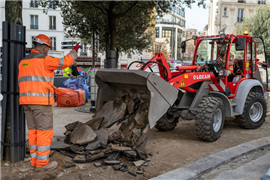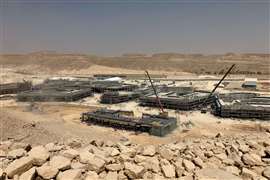Read this article in Français Deutsch Italiano Português Español
Compact equipment: How smaller is working bigger
22 August 2025
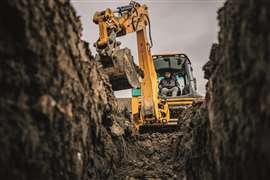 An operator digs a trench with a mini excavator (Image: AdobeStock)
An operator digs a trench with a mini excavator (Image: AdobeStock)
From upgraded loaders and dozers to new electrics and excavators, the strategy is clear: rather than chasing a single ‘universal compact machine,’ companies are tailoring platforms around specific users and their most frequent challenges. Mitchell Keller reports.
Overlapping forces are driving a shift in the compact equipment market, from labour shortages, tighter jobsite footprints, and increasingly aggressive environmental standards.
In turn, compact equipment must now deliver full-scale output with reduced emissions, in tighter spots, with faster operator onboarding.
Lower machine sales could drive compact value
After three years of record equipment demand in North America and elevated volumes across developed markets, 2024 marked the start of a cyclical downtrend.
According to Off-Highway Research (OHR), global equipment sales declined by 2% last year, with a further 2% dip expected in 2025 before the next upturn begins in 2026.
“Equipment sales in the developed markets of Europe, Japan and North America all fell last year, and Europe had a particularly hard landing,” says Chris Sleight, managing director of OHR.
Compact equipment was seen as vulnerable in certain segments; a 17% drop in the European residential market was made worse by a depressed housebuilding sector and compounded by regional political instability. North America’s compact segment fared better but still saw a 5% decline in overall equipment sales as fleet saturation and policy uncertainty began weighing on procurement.
However, compact machines could rebound quicker than their bigger brothers, particularly as contractors seek better value for an increasing amount of civic and infrastructure builds, which are leading construction in key regions across North America, Asia and Europe.
“Compact equipment is often the first to respond in a downturn and also the first to recover, especially where infrastructure activity is strong,” Sleight explains.
Rental-first philosophy drives platform design
With demand rising in civic urban builds, US-based Case Construction Equipment, a CNH Industrial brand, is building compact platforms with rental and dealer models in mind.
“We’ve focused heavily on delivering machines that meet the needs of high-turnover rental applications,” says Terry Dolan, head of CNH Construction Brands, North America. “That means ease of use, ease of service, and performance that holds up over time.”
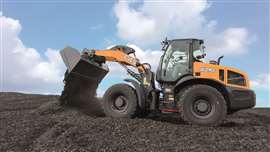 The Case Construction Equipment 421G wheel loader (Image: Case)
The Case Construction Equipment 421G wheel loader (Image: Case)
Case’s new 421G compact wheel loader, for example, delivers 112 hp and nearly 16,900 lbs of breakout force - a level of performance typically seen on larger equipment - but with a control layout and cab comfort package designed for operator turnover and uptime visibility. It ships with full telematics integration, including its vision system SiteWatch, and prioritises serviceability, transport ease, and compatibility with high-cycle attachments like sweepers and forks.
So, from owner to operator, making machine use easier is the name of the game for Case. Dolan adds, “That’s what we set out to do for rental businesses with our latest round of innovations.”
Rental firms are seeing evidence that compact machines are becoming core fleet assets, not peripherals. The world’s largest construction equipment rental firm, US-based United Rentals, reports a 4.3% rise in fleet productivity in Q4 2024, with US$3.4 billion in rental revenue; showing demand held firm in spite of broader market softness.
Meanwhile, UK-based Ashtead Group says rental penetration “could be well over 60% in the US,” driven by rising regulation, cost pressures, and ergonomics.
Dutch firm Boels Rental grew revenue 11.6% in 2024, citing strong investment in fleet, technology, and “mega‑projects” like data centres and energy transition assets, especially for the European market.
An ‘E’ for Hitachi Compact Machinery
Hitachi Construction Machinery unveiled its largest-ever electric equipment range at Bauma 2025, with two compact excavators anchoring the lineup: the ZX17U‑6EB in the 1.7‑tonne class and the ZX55U‑6EB in the 5.5‑tonne segment.
Both models were part of a broader zero-emission strategy targeting urban construction and rental markets.
The ZX55U‑6EB – the company’s first 5‑tonne battery-powered compact excavator – builds on Hitachi’s previous electric mini platforms with upgraded lithium-ion batteries and a standard on-board charger.
The ZX17U‑6EB marks the start of a strategic technical collaboration with US-based electrification firm Dimaag‑AI. Dimaag’s ENCORE system powers the ZX17U‑6EB, pairing swappable high-power battery modules with active thermal management, EV motors, and integrated safety controls. Built for continuous off-road use, ENCORE debuted at CES 2024 and was adapted specifically for Hitachi’s compact platform.
Ian Wright, Tesla co-founder and now VP of engineering at Dimaag, called the partnership “a critical step toward electrifying agricultural and construction machinery.”
The ZX17U‑6EB is still in prototype phase, with a launch planned for 2027. The ZX55U‑6EB is currently sold in Europe.
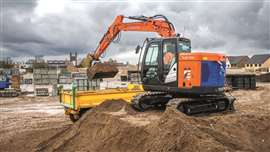 The Hitachi Construction Machinery ZX85-6EB compact and electric excavator, which is currently available in Europe. (Image: Hitachi)
The Hitachi Construction Machinery ZX85-6EB compact and electric excavator, which is currently available in Europe. (Image: Hitachi)
Thriving in confined, urban environments
While compact machines’ utility means value for small and mid-sized contractors, the largest contractors are increasingly turning to smaller fleets for jobs in tight city builds.
At UK-based JCB, the OEM sees compact equipment as a global problem-solver. Lee Tice, JCB North America’s product manager for compact equipment, describes how compact machines have shifted from niche roles to core contributors on every continent.
“From densely populated urban centres to remote infrastructure sites, compact machines are taking on more responsibility across geographies and job types,” says Tice.
JCB’s single-arm boom skid steers and teleskid models reflect that approach, offering side-entry cab access and superior sightlines in congested work zones. Unlike conventional two-arm machines, the design removes the need to climb over attachments, improving both daily workflow and operator safety.
Back at Case, the OEM’s CX85E and CX90E midi excavators bridge the gap between compact utility and mid-weight earthmoving. Both machines run on a 72-hp engine and offer high attachment flow but diverge in form: the CX85E features a zero tailswing fixed boom, while the CX90E includes an offset boom with 180° of movement and greater reach.
These differing choices reflect a deeper bet on jobsite specificity in the compact market, especially in urban environments where performance can’t come at the expense of manoeuvrability.
“The goal is to provide crews with the power, versatility and precision they need to succeed in an increasingly competitive industry,” Dolan says.
Numerous other global manufacturers are leaning into this same logic. At Bauma 2025, Turkey-based Hidromek introduced the HMK 70 CR and HMK 85 SR midi excavators, both under ten tonnes and engineered for confined-area work in cities and agricultural plots.
The HMK 70 CR includes a swing boom for offset digging and a swing radius of just 400 mm, while the HMK 85 SR uses a short-tail swing design. Both machines include features typically seen in higher-tonnage models, such as wide-view cabs, reversing cameras, and multi-function hydraulic systems, to aid vision and safety for confined worksites.
Chinese OEM Lovol is focusing its compact strategy around flexibility and attachment versatility. Its newest compact excavator, the FR55F-u, was designed for multi-function use across varied applications, from trenching and backfilling to material handling.
“With the advance design for multi-functional attachments,” the company tells International Construction, “FR55F-u can meet with different working conditions to realize one machine multi-purpose function.”
China-based SDLG’s latest compact excavator demonstrates how far OEMs are willing to go to embed comfort and simplicity into small machines. The model includes a fully adjustable seat, low-noise cab, and high-definition touchscreen control panel.
SDLG has also embraced attachment diversification to drive utilisation. Specialised tools – including trenching buckets, hydraulic breakers, forks, and landscape mowers – allow compact models to operate more like platforms than single-task machines.
Caterpillar refreshes compact loader lineup
In early 2025, Caterpillar unveiled a major update to its compact loader portfolio, introducing new skid steer models (250, 260, 270, and 270 XE) and compact track loaders (275, 275 XE, 285, and 285 XE).
The redesigned lineup features a new naming convention – skid steers ending in “0” and track loaders in “5” – intended to simplify product identification.
Performance upgrades include up to 50% more torque on track loaders, higher lift heights, increased breakout forces, and closed-centre high-flow hydraulics compatible with Smart Attachments.
The operator station has also been overhauled for better visibility, cab space, and comfort.
According to Caterpillar, the updates aim to deliver more flexibility and productivity in demanding compact equipment applications.
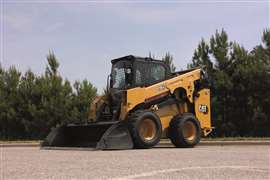 The Cat 270XE compact skid steer (Image: Caterpillar)
The Cat 270XE compact skid steer (Image: Caterpillar)
Updating tech, safety, electrification
Tech, safety standards, and global electrification are steering many of the biggest updates to compact equipment.
Radar-based rear object detection now comes standard on some Case machines, and a new bi-directional self-levelling system helps prevent load spill while lifting or lowering.
JCB is advancing telematics, intuitive controls, and hydraulic modulation. Its aim is to make it easier for operators to switch between machines or brands, while supporting fleet managers with software to track uptime, usage, and maintenance.
“We want the operator experience to be consistent no matter what machine they’re in,” says Tice. “That’s how you reduce downtime and increase productivity.”
This kind of consistent operator experience helps contractors and rental firms reduce training time and better manage large, mixed fleets.
Hidromek also emphasises user-first tech. The HMK 70 CR includes a tilting cab for faster service access, fully opening covers, and a touchscreen operator display with ergonomic controls. The larger HMK 235 LCR carries similar logic into tight-access heavy urban work.
Electrification, albeit slowly, is gaining traction in Europe and Asia-Pacific; adoption remains heavily influenced by local incentives, grid access, and contractor familiarity. Flexible solutions that combine traditional form factors with clean power are rising in value as transport, labour, and logistical constraints mount.
JCB has developed a Stage V-compliant version of the Teleskid and launched a hybrid 1CXT backhoe-compact track loader.
Hidromek previewed its first fully electric crawler excavator, the HICON 70 CE, a seven-tonne model designed for urban environments.
Zoomlion, one of China’s largest equipment manufacturers, has prioritised electric compact machines across both its earthmoving and aerial work platforms. Its electric skid steer loader has eliminated hydraulic oil entirely, achieving 80% lower energy use and 60% less noise.
“There is strong and growing demand for electric compact machines globally,” the company tells International Construction, adding the decision is “driven by carbon-neutrality targets and stricter environmental policies.”
The company’s ZE145GU compact excavator features a fully electronic control system for remote operation and automated construction.
“With its self-developed algorithm,” the company says, “the ZE145GU is easy and precise to operate, and it can also achieve remote control and automated construction under special working conditions.” Zoomlion has also developed smart helmets with obstacle detection, collision alerts, and MEWP interlocks. Its new Equipment Authorization Management System also adds project-based restrictions and geo-fencing tools.
SDLG’s electric mini excavator, now in European and North American markets, was developed to meet zero-emission mandates and reduce lifecycle costs. The machine is said to emit no exhaust, generate minimal noise, and eliminate the need for oil and filter changes.
“Compared to traditional fuel-powered equipment,” SDLG says, “electric equipment does not require frequent replacement of consumables… reducing maintenance costs.”
Compact machines are no longer confined to niche roles or entry-level hires. As this year’s launches and deployments show, they’re being designed – and increasingly relied on – as serious tools for high-stakes, compliance-heavy, and productivity-focused work.
With growing demand from rental firms, urban contractors, and infrastructure clients alike, the smallest machines are now shaping some of construction’s biggest priorities.
John Deere unveils major upgrades to backhoe loaders
John Deere has introduced a range of machine and operator-focused updates across its backhoe lineup.
Key changes include a redesigned cab with more swivel room, improved airflow, and enhanced sightlines for trenching and truck-loading tasks.
International Construction got an early look at the upgrades in March at John Deere’s Sacaton, Arizona, US, testing facility. There, the 320 model was featured, with a Deere representative calling it “completely redesigned from the ground up.”
It includes a rear camera system, which can display split or stitched views on an 8-inch in-cab screen, which is believed to be an industry-first factory install.
The backhoe cab had not undergone a full redesign in more than 20 years, making this upgrade one of the most significant changes to the models in decades.
Other new or enhanced features include: Optional stabiliser locks and position warning system (all models), sealed switch module for keyless start and simplified control access (standard) and wider cab and redesigned pilot towers for easier movement between loader and backhoe positions
The upgrades follow recent performance-focused additions, such as optional heavy lift mode and pressure-compensated load-sensing (PCLS) hydraulics on the 320, 410 and 710 P-Tier models.
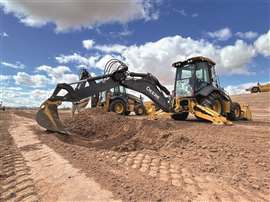 A John Deere backhoe loader in action (Image: Mitchell Keller)
A John Deere backhoe loader in action (Image: Mitchell Keller)
STAY CONNECTED



Receive the information you need when you need it through our world-leading magazines, newsletters and daily briefings.
CONNECT WITH THE TEAM










